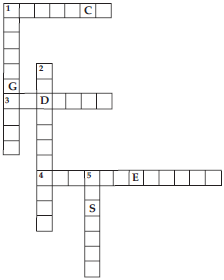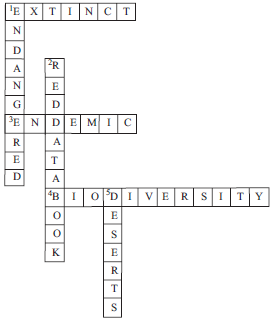Conservation of Plants and Animals (Biology) Class 8 - NCERT Questions
Fill in the blanks:
(A) A place where animals are protected in their natural habitat is called ––––––– .
(B) Species found only in a particular area is known as ––––––– .
(C) Migratory birds fly to far away places because of ––––––– changes.
(A) national park, (B) endemic species, (C) climate.
Q 2.Differentiate between the following:
(A) Wildlife sanctuary and biosphere reserve
(B) Zoo and wildlife sanctuary
(C) Endangered and extinct species
(D) Flora and fauna.
(A) Wildlife sanctuary is a protected land area reserved for the conservation of wild animals and birds. Hunting is strictly prohibited there.
A biosphere reserve is a specified land area in which multiple use of land is permitted for preserving biodiversity. It is divided into three zones for different activities:
(i) Core zone where no human activity is permitted. It is also known as natural zone.
(ii) Buffer zone where limited human activity is allowed.
(iii) Manipulation zone where several human activities are permitted.
(B) Zoos are the places where some animals are protected in artificial habitats for public view. Wildlife sanctuary is a conservation of wild animals and birds in their natural habitat.
(C) The species which are at the verge of extinction and require protection and conservation are called endangered species. e.g., blue whale, Indian rhinoceros.
The species which are no more existing on the earth are called extinct species e.g., dodo.
(D) Term flora is used for all the varieties of plants inhabiting a particular area while term fauna is used to refer to all the varieties of animals inhabiting a particular area.
Discuss the effects of deforestation on the following:
(A) Wild animals
(B) Environment
(C) Villages (Rural areas)
(D) Cities (Urban areas)
(E) Earth
(F) The next generation.
(A) Wild animals: Deforestation destroys the habitats of many wild animals. They are left to die without their natural shelter.
(B) Environment: Deforestation affects the environment adversely due to the disturbance of ecological balance. The amount of carbon dioxide is increased in atmosphere and causes global warming.
(C) Villages (Rural areas): The villagers depend on forests. They are closely related to forests. Due to deforestation various wild animals run to nearby villages and cause danger to them. Villagers cannot get fruits, fuel wood due to deforestation.
(D) Cities (Urban areas): Deforestation does not affect the life of cities directly. But changes in climate affect cities. Calamities like flood and droughts do not spare cities.
(E) Earth: Deforestation affect the earth severely. The fertile land of earth is converted into deserts and its temperature rises. It changes its climate and environment.
(F) The next generation: Many beautiful fauna and flora are destroyed due to deforestation. So, next generation will not be able to see them. They will not have clean and healthy environment.
What will happen if
(A) we go on cutting trees.
(B) the habitat of animal is disturbed.
(C) the top layer of soil is exposed.
(A) If we go on cutting trees then:
(i) Ecological balance will be disturbed
(ii) Earth will loose top fertile layer and will be converted into desert.
(iii) Floods and droughts will become more frequent.
(iv) Many animals will lose their shelters.
(v) There will be scarcity of things like fruits, paper, wood which we get from forests.
(vi) Global warming will occur.
(B) If the habitat of an animal is disturbed, it will ultimately become extinct.
(C) Exposure of the top soil will lead to its erosion. Removal of the top layer of the soil exposes the lower, hard and rocky layers. This soil has less humus and is less fertile. Gradually the fertile land gets converted into deserts. It is called desertification.
Answer in brief.
(A) Why should we conserve biodiversity?
(B) Protected forests are also not completely safe for wild animals. Why?
(C) Some tribals depend on the jungle. How?
(D) What are the causes and consequences of deforestation?
(E) What is Red Data Book?
(F) What do you understand by the term migration?
(A) Conservation of biodiversity is essential because of the following reasons:
(i) Biodiversity maintains balance in the ecosystems.
(ii) Wild animals and plants provide a variety of commodities.
(iii) Wildlife is needed for breeding programmes in agriculture, horticulture, sericulture, apiculture, etc.
Any damage to biodiversity will threaten the whole support system and will be a threat to human existence. Therefore, biodiversity needs to be conserved.
(B) The protected forests are also not completely safe for wildlife because illegal poaching takes place at large scale in these areas.
(C) Some tribals depend on jungle for their food, clothes, shelter, wood, medicines and other requirements.
(D) Man-made causes of deforestation are :
(i) Procuring land for cultivation.
(ii) Building houses and factories.
(iii) Making furniture or using wood as fuel.
Some natural causes of deforestation are forest fires, severe droughts, landslides, earthquakes, floods, etc.
Deforestation is responsible for desertification, natural calamities, reduced rainfall, change in climate, scarcity of products and global warming.
Many species of plants and animals are destroyed due to deforestation.
(E) Red Data Book is the record book and source book of all the endangered animals and plants.
(F) Some animals, especially birds, travel from their homes or habitats to a different geographical areas, often following a seasonal pattern. This movement is called migration.
In order to meet the ever-increasing demand of factories and for shelter, trees are being continuously cut. Is it justified to cut trees for such projects? Discuss and prepare a brief report.
SOLUTION:The continuously cutting of trees is not justified for any project. We do not only cut the trees, we snatch away the shelters from many animals, birds and other organisms. The ecological balance is also disturbed. It also causes many natural calamities.
Q 7.How can you contribute to the maintenance of green wealth of your locality? Make a list of actions to be taken by you.
SOLUTION:We should take following actions for the maintenance of green wealth of our locality:
(i) We can grow more and more plants in our locality.
(ii) We can protect them and provide water to them.
(iii) All the residents should be taught about the benefits of trees.
(iv) They should also be taught about the harms of cutting of trees.
Explain how deforestation leads to reduced rainfall.
SOLUTION:Plants maintain the water cycle in the environment. If plants will not absorb water from soil they will not evaporate it in the environment to form clouds. If clouds will not be formed then no rainfall will take place. In this way deforestation reduces rainfall.
Q 9.Why should paper be saved? Prepare a list of ways by which you can save paper.
SOLUTION:The wood pulp is used in manufacturing the papers. It takes 17 full grown trees to make one tonne of paper. So, we should save paper to protect our trees.
Ways to save papers are as follows:
(i) We should not throw paper here and there.
(ii) Waste paper should be collected and send for recycling.
(iii) We should reuse the used paper.
Complete the word puzzle.
Down
1. Species on the verge of extinction.
2. A book carrying information about endangered species.
5. Consequence of deforestation.
Across
1. Species which have vanished
3. Species found only in a particular habitat.
4. Variety of plants, animals and microorganisms found in an area.

